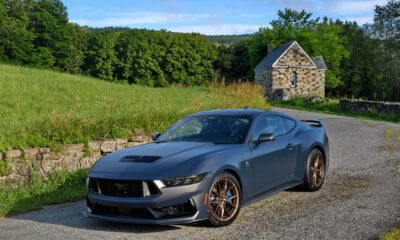
Photo: Jonathan Grace
The Ford Mustang Mach-E was the Blue Oval’s first fully-fledged electric vehicle when it initially went on sale in late 2020, and more than two years later, it continues to be one of the key players in the market.
Born out of Ford’s ‘Team Edison’ skunkworks department in the Corktown neighborhood of Detroit, the crossover SUV, bearing the name of the world’s best-selling sports car, had big shoes to fill, particularly from diehard muscle car enthusiasts that expect nothing less out of the legendary brand.
Yet, as we discovered in our weekend with the Mustang Mach-E while covering the recent IMSA event at WeatherTech Raceway Laguna Seca, Ford has cleverly blended its pony car heritage with the practicality and sustainability of the ever-changing industry to produce an EV that doesn’t sacrifice performance.
Featuring a sleek and muscular body combined with an aggressive front fascia and signature tri-bar taillights, the Mustang Mach-E has a recognizable, yet fresh appearance. It doesn’t necessarily fit the typical Ford mold, with its upscale interior styling and features nearly placing it into the luxury vehicle segment.
Our mid-tier 2023 Premium RWD model (MSRP $64,875) came well equipped, including with an optional extended-range 91 kWh battery with an EPA-estimated range of 306 miles, that allows for an additional 18 kW of power from the single, rear-mounted electric motor producing 216 kW (290 horsepower).
The higher-end GT and GT Performance Edition models, meanwhile, deliver up to 358 kW (480 hp) through a dual motor, all-wheel drive configuration, although it comes at a sacrifice to range, with an estimated 270 miles for the GT and 260 miles for the GT Performance.
Even with the RWD model, there was plenty of power on tap, with 0-60 mph in 6.1 seconds. Impressively, the GT and GT Performance nearly cuts that figure in half, coming in at 3.8 and 3.5 seconds, respectively.

Photo: Jonathan Grace
Three different drive modes are available (Whisper, Engage and Unbridled) and can be activated from the massive 15.5-inch vertical touchscreen display that features a mechanical volume and temperature dial. A 10.2-inch digital instrument cluster screen, meanwhile, offers a perfectly-sized display that provides vital information such as speed (listed as “ground speed” in a nod to the Mustang heritage) as well as battery and range info.
One of the more impressive features is its integration with Apple CarPlay, which is wireless, and includes EV routing with Apple Maps, having been the first vehicle to adopt this feature last year via a software update.
While we didn’t have to put EV routing to its test during our 100-mile journey from San Fransisco to Monterey, Calif. via Highway 1, having that feature, outside of Ford’s native navigation system, would come in handy on longer road trips.
Ford’s driver assist system, BlueCruise, however, stole the show, with a recent update to version 1.2 now offering a hands-free driving experience on selected highways. The system worked for part of our trip down to Monterey, but was best used on Highway 101 on the way back to the airport following the race.
Similar to Tesla’s Autopilot, BlueCruise keeps the vehicle in the lane at speed and can also handle lane changes. The hands-free feature works via a driver-facing camera that follows eye movement. Alerts quickly come up on the dash even if the driver just briefly glances away from the road.
Compared to driver assist-equipped EVs from a half-dozen other manufacturers we’ve driven, BlueCruise appeared to offer the most stable and consistent system, and could arguably be considered better than Tesla’s Autopilot if you’re often traveling on Ford’s covered 130,000 miles of highways in the U.S.

Photo: Jonathan Grace
The Mustang Mach-E also excels in the charging department, with the FordPass app allowing for plug-and-charge at selected public DC charger networks that alleviates the need to enter payment information that’s instead stored in the central app. It is one of only a few manufacturers to offer such a service.
We tried it out at an Electrify America station in Pacific Grove, Calif., which had our vehicle charging up to its maximum speed of 150 kW in seconds after connecting the cable. While not as fast as the Hyundai, Kia and Genesis models as well as the Porsche Taycan’s industry-leading 800-volt system, it was still sufficient enough and kept us at the charger for a half-hour to get back to an 80 percent charge.
Ford drivers won’t be limited to the CCS fast-charging network for long, as it was announced this week that Ford EVs will be able to use Tesla’s Superchargers beginning next year with a provided adapter, while next-generation Ford models will come with Tesla’s North American Charging Standard (NACS) built-in beginning in 2025.
This will open the door for Ford drivers to access more than 12,000 North American Superchargers, which have a near-perfect reliability record compared to the hit-or-miss nature of CCS stations that have been non-Tesla EV drivers’ principle complaint in recent years.
Those looking for an alternative to a Tesla Model Y but still want to reap the benefits of Tesla’s fast-charging network, the Mustang Mach-E will soon become an even more convincing option, although there is still a rather large price gap between the two cars, with Tesla continuing to discount the Model Y in the U.S. and elsewhere.
But with its distinctive design, performance potential and future-proofed charging network, the Mustang Mach-E nearly checks off all of our boxes as one of the best EV options available today.

Photo: Jonathan Grace
























